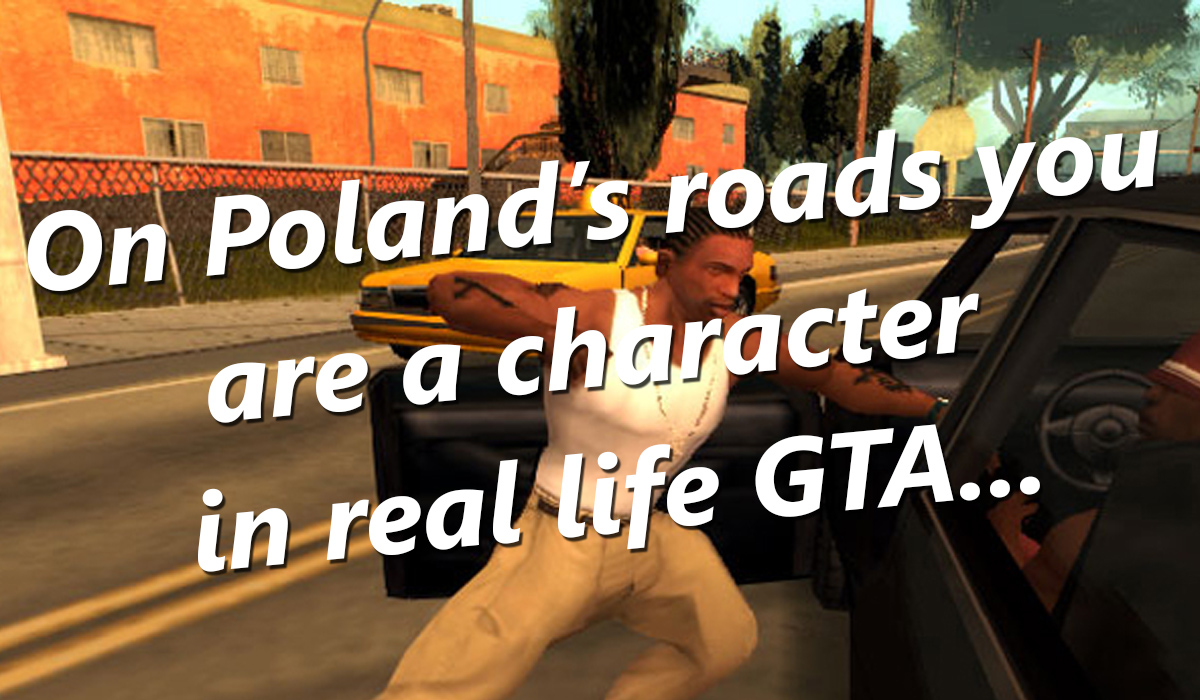If you ever drove in Russia, Democratic Republic of Congo or Colombia – then you are well prepared for driving on Polish roads.
You can stop reading here, you won’t learn anything new as you already know how it is like.
If you are used to driving in more civilised countries though, a culture shock you will encounter in Poland will be severe.
Below you will find enough information to avoid the fate of the poor holidaymaker from Denmark, who got beaten up on Polish street in front of his three terrified children:
As you will see further down, the above behaviour is not a rare exception on our roads. And it is only a part of a bigger problem.
Due to severity of the problem, this article has grown so large, that the following table of contents may be of use:
- Overview
- Motorways and Expressways
- National speed limit roads
- Law of Gross Tonnage
- Reluctance to use speed cameras
- Inadequate driver training
- Poor Technical Condition of Cars
- Yanosik – the speeding app
- Drunk driving
- Riding a motorcycle/scooter in Poland
- Super-lenient penalty point system
- Insurance
- Important People (no media coverage, no justice)
- Being a pedestrian (aka „dead man walking”)
- Cycling in Poland
- Disabled drivers in Poland
- How to survive on Polish roads?
- Is There Hope?
Being an EU member state does not mean that people magically become civilised overnight.
We are still an Eastern European country and our post-Soviet mentality shows in the typical mix of aggression, incompetence and reckless disregard for law or rules of any kind.
Getting beaten up and having your children traumatised by the sight is also not really as bad as it can get here: they could all be dead too.
Historically Poland has some of the worst drivers in Europe and some of the most dangerous roads. A look at the statistics leaves no doubt about this.
Poland constantly occupies the “top three” of Europe’s road death statistics, along with countries that share similar “driving culture” (or lack thereof), like Bulgaria and Romania.

My own perspective I am about to offer to you is quite unique. I am Polish, but I learned to drive in Ireland. Until very recently, I have never driven on Polish roads.
For many years I drove on one of Europe’s safest roads, naively thinking this is the norm. Little I knew…
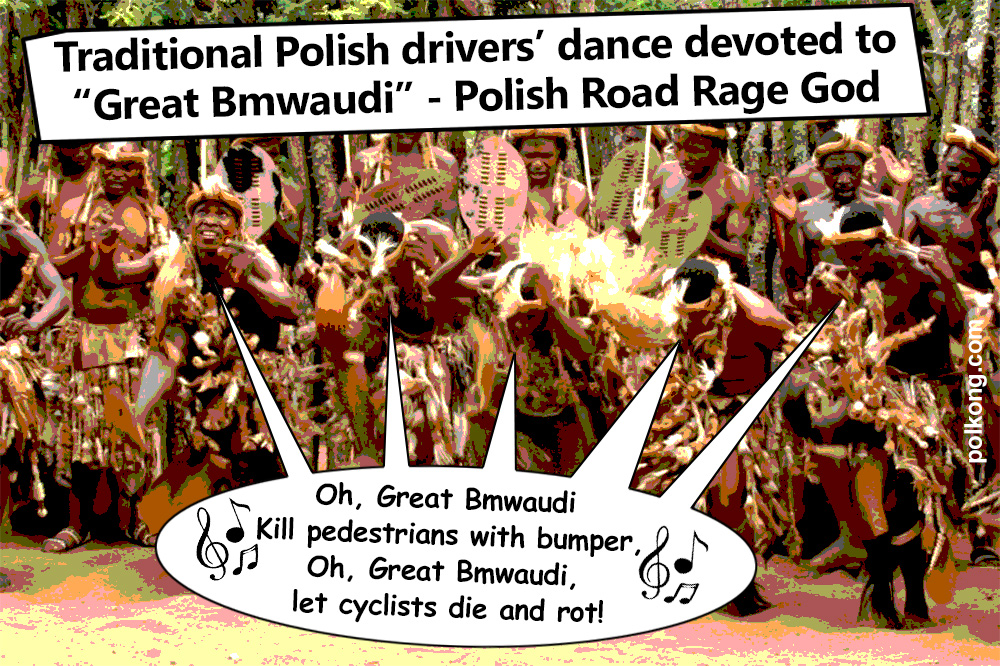
So while I am Polish myself and can understand the natives, I also have a foreigner’s or tourist’s/holidaymaker’s perspective on the barbaric state of affairs on Polish roads.
To make it short: unless absolutely necessary, I strongly discourage you from driving on Poland’s roads.
It is dangerous, frustrating and not fun at all.
If you really have to, at least avoid driving outside of cities. The most mind-boggling stupidity of Polish drivers happens on the national and higher speed limit roads.
If you want to know more, please read on.
Overview
The Polish treat rules of the road in a similar way Pirates of the Caribbean treated their code. They are more like guidelines.

Unsurprisingly, in Poland nobody obeys speed limits. Some drive faster, some much faster than the limit.
Exceptions do happen, but the reason usually is that the driver is elderly or a learner driver accompanied by a driving instructor.
Moreover, obeying speed limits in Poland is dangerous. Polish drivers are used to driving faster than allowed and will get aggressive when encountering someone driving to the speed limit.
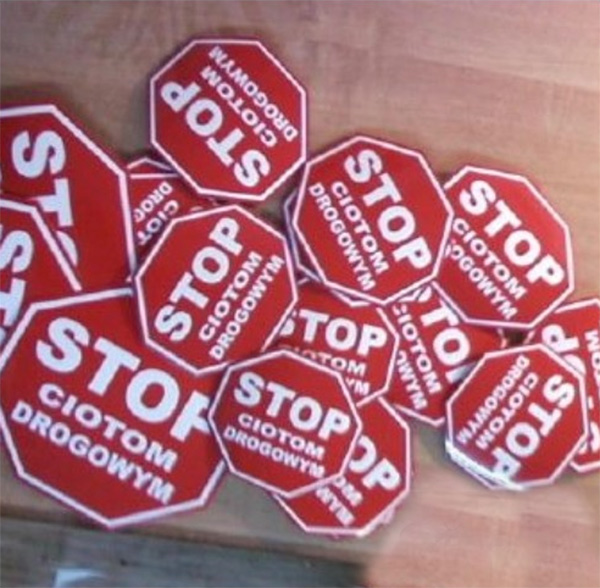
Penalties are low or non-existing, traffic police is invisible to the point that one wonders if it exists at all.
There is a notorious case of a boyracer guy going by the nickname of “Frog” – his driving style can be seen below, as proudly recorded and published by himself.
It took Polish courts 8 years to finally sentence „Frog” for multitude of offences – instances of dangerous driving, driving without a license, driving while disqualified from driving – the list goes on.
After 8 years he got a joint sentence of 2 years and 6 months in prison – only because the case caught public attention.
Meanwhile he kept racing and getting repeatedly caught while doing so.
No he is (obviously) not in prison – appeal pending. As a result you can still meet the man on our roads… head on.
Update: as one of his earlier sentences (1.5 year in prison) finally became legally binding, the man just disappeared. What a surprise!
After 10 months of waiting for the man to show up in prison, Polish state issued an arrest warrant… so we are still waiting.
So does Polish failed state deal with cases that occupy first pages of the newspapers: 8 years of complete impunity and repeated offences – and counting.
A little hint: the guy is rich and has parents with connections. This is a common theme in cases where Polish courts exhibit particularly extreme leniency and understanding.
And so we have been unable to stop one boyracer for over 8 years. Guess how we deal with serious offenders… we don’t.
Those who do not post evidence against themselves on youtube (like forementioned „Frog” foolishly did) have absolutely nothing to worry about.
Do you like dangerous driving? Come to Poland!
In this beautiful country you can take my life, life of my friends and life of my child and play with them as you please to prove yourself on the road.
If you ever dreamed of GTA in real life, Poland is the place to make your dreams come true.
Just like in the game, even if you kill us all, you’ll get out scratch free due to unbelievable leniency of our courts.
I am sure by now you are thinking I am grossly exaggerating. Really?
Then watch and try to guess, what is the penalty for such behaviour in Poland:
Answer: at the very most 1200 euro fine (5k PLN). This is the maximum the guy can get. This criminal assault is not even treated as such.
I wonder what would he get in the UK where he lives (the guy is Polish, was spending holiday in Poland and playing GTA live for entertainment).
Dear Brits, I understand that knowing that the above asshole is driving on your roads now may be a bit unsettling. But please, I beg you, do not deport this idiot. We have a whole army of them in here already… just keep at least this one, will you please?
You can keep him in a cage or something, I don’t care. Just make sure he is on a leash or a chain and everything will be fine.
On the video you can hear a woman call the police in panic. They tell her to come to a police station to make a statement… while she is being attacked in her car, in broad daylight, on a public road.
This neatly summarises help you can get from the police in Poland. If attacked, you are on your own, just like the family in the video above.
Want an adventure? Forget Venezuela and visit Poland instead!
After about a year of very casual driving in Poland (10k km a year), almost exactly the same situation as above happened to me.
There was more traffic and „my guy” did not manage to stop me. He took offence of me overtaking at 140 kph on a 140kph limit motorway.
At some stage I had my pepper spray in my hand (I carry one in my car at all times – you should too if you want to drive here) as it looked that I will be forced to stop and will have to defend myself and my girlfriend who was with me.
I had no dashcam – my bad. I have a dual one now, front and back. Another lesson learned. You see I have driven for more than a decade in Ireland and never felt a need for a dashcam.
I was wondering what the people have them for. Now I know.
In Poland a dashcam is a must – a bit of a deterrent and evidence in case of very popular hit and run.
As much as I dislike such constant surveillance, I think in countries like Poland dashcams are the way to go. Once people know they are very likely to be recorded, many of them will start to behave.
Maybe I was just unlucky. I also drive to speed limits – this alone provokes lots of aggression here. Or maybe in Poland it is statistically enough to drive 10k km before you get assaulted like the family in the video above.
I don’t know.
Telescopic batons are legal in Poland (so you can expect to be attacked with one), but I would not recommend using one yourself.
In Poland you can only use „proportional force” in self-defence. To be on the safe side you have to make your self-defence a fair duel and give the attacker equal chance, otherwise you risk serious legal problems.
There was an attempt to change the law recently and give the victims a bit more of protection in case they choose to fight back. From what I read the law is still as vague and open-ended as before. A guideline instead of a law, as usual here.
It is hard to judge what a proportional force is while fighting for your life. So if there is any way to escape, you should use it instead of fighting back. The court may look more favourably at the victim who attempted escape before fighting back.
It is not unrealistic that defending yourself or your child you will land a sentence yourself, especially if you hurt the attacker. Keep that in mind.
Because of the above, I recommend the pepper spray – it is better than nothing and least likely to generate legal problems for you. No long-standing effects the attacker could sue you for.
If you normally live in a safe country and have no experience with such things, buy two cans and practice with one to see how far it sprays etc. Sooner or later you will have to use it in real life, no time to learn when panicked during attack.
You may wonder why on Earth do we allow all this stuff to go on like this. It is simple:
In Poland it is impossible to enforce road laws, because it would mean pissing off majority of drivers – and in consequence enough voters to loose elections.
Lost elections mean no jobs for the boys. The largest state-owned companies (like dreadded Modlin Airport) are a place, where politicians’ families get well paid employment without having to work.
Politicians in Poland do not even try to hide this fact, it is done in a completely official and open way.
I guess it is Polish version of transparency…
To keep things smooth all governments are issuing laws that are then not enforced and carry just small cash penalties.
Very recently (2021) penalties for road offences went up in Poland, but watch the statistics. Nothing will change, due to no enforcement.
This clever strategy lets the politicians keep their hands clean without actually addressing problems and stepping on their voters’ toes.
Their relatives keep their state-sponsored income only as long, as they are in power.
As a consequence, Poland’s roads are a paradise for street racers and those who like to live on the edge with total disregard to the lives of others. Poland’s roads are ruled by criminal types and the only law in force is the law of the fist.
Dangerous drivers operate in Poland with almost complete impunity. Safe drivers get no help and are left to themselves.
If you want to drive safely, you will constantly be a victim of road rage, intimidation and dangerous driving of others who consider you to be an obstacle.
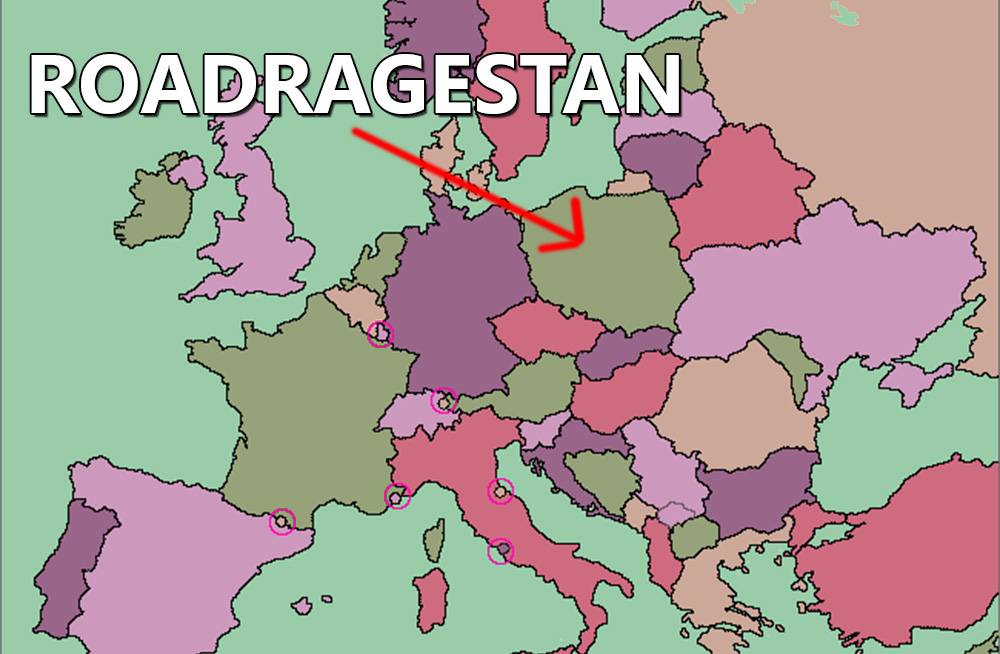
Aggression on Polish roads is commonplace and impunity of dangerous drivers shows how disorganised we Polish are as a society.
What happens on the roads, happens elsewhere too – in different forms, but following similar patterns.
The lunatics have taken over the asylum here.
Polish roads are areas of the country virtually exempt from the rule of the law.
If you are a psychopath and want to hunt people, then get in your car and come to Poland. If sober, you can kill at least one person without any legal consequences, just for fun.
Just do not forget to say you are sorry, this is very important.
The utter frustration an helplessness I feel about those things made me write this post.
Motorways and Expressways
Poland – together with guess who – Bulgaria (equally road safety challenged nation) has 140 km/h speed limit on motorways.
Not fast enough for most Polish.
Aggression takes many forms, but extreme tailgating is the most common of the Polish motorway specialties.
Polish governments bravely issue laws that even more forbid such practices. Unfortunately, no penalties follow.
As usual we get a guideline instead of a law.
Another words, these new laws will not be enforced, just like existing ones. They are merely a PR stunt to show the society that the government is doing something.
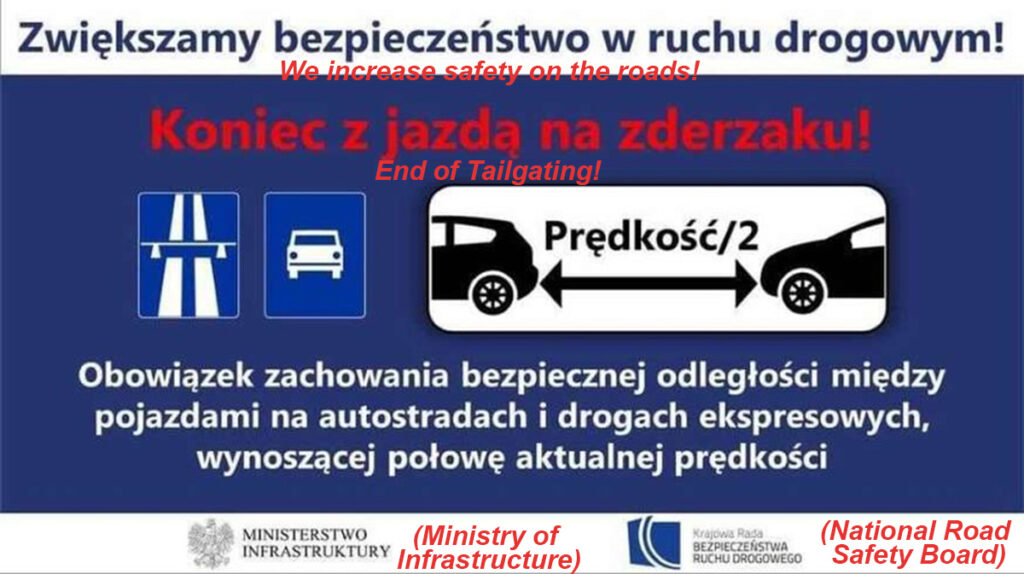
Like I said vast majority of Polish drivers do not obey any rules. If penalties were introduced, politicians would loose votes.
Driving on Polish dual carriageways and motorways is frustrating, because if you want to obey speed limits, you can’t overtake.
So if you want to avoid potential accidents and scuffles with thugs, you will be stuck behind HGVs that do 90kph. The left lane (vast majority of Polish motorways have just two lanes) is reserved for those driving faster than speed limit.
If you try to overtake at speeds around speed limit, they will dangerously tailgate and blink their high beam lights to let you know that you have to get out of their way immediately.
Many accidents occur every year when a law-obeying idiot is not fast enough to get out of the way and gets hit from behind or you loose control of your car when the overtaking vehicle gives you a bit of „penalty braking” (brake checking).
This is what commonly happens:
What is „penalty braking” you may ask. Here you go: if you are too slow getting out of the way of a car driving above speed limit in the left lane, it is customary that overtaking vehicle will get in front of you and hit their brakes, forcing you to stop.
This way they let you know how it is to be stuck behind a vehicle doing the speed limit. They teach you a lesson.
This is exactly what caused the accident on the video above and in Poland we call it „penalty braking”.
This practice is well known among Polish driver. When you see a car tailgating you while you overtake on a motorway, be prepared to brake once they get in front of you.
Also, sometimes it is best to escape into the hard shoulder/emergency lane as otherwise you can get sandwiched between the penalty braker and the car behind.
This knowledge may save your life, it saved mine at least a few times.
Penalty braking is so common that you are bound to experience it if you drive on Polish motorways and dual carriageways. It is guaranteed to happen if you overtake without exceeding the speed limit.
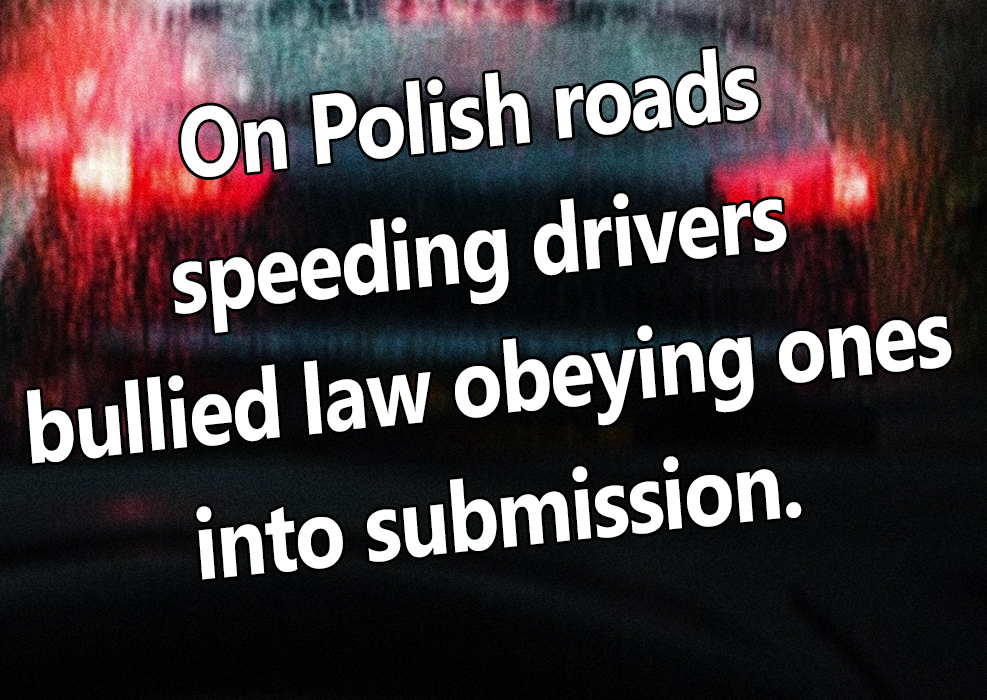
It is heartbreaking to see people run for their dear lives when you approach them on the left lane. This shows how badly Polish law and state failed their citizens. The criminals and idiots run the show here.
Ordinary people know they have no right to be in the motorway’s left lane. This is madness.
On Polish roads speeding drivers bullied law obeying ones into submission. You get out of their way or face consequences – often deadly ones.
These prison-like customs are an accepted norm on Polish roads.
Just like in prison, after 15 minutes on a Polish motorway you’ll be taught your lessons and shown your place in the pecking order.
So if you have to drive on Polish motorways (or dual carriageways called express roads here with 120kph speed limit), for your own safety please stick to the slow right lane.
Running away from angry tailgating racers while overtaking will make you tired and you will not gain much time anyway as you will be constantly pushed aside.
The only precise statistics I could find come from 2016 and say that 51 people lost their lives and over 3000 got injured due to tailgating alone.
National speed limit roads
Polish national speed limit is (in theory) 90kph. Of course, this speed limit is treated more like a guideline.
Like all speed limits in Poland, this one also operates on a honorary basis and is almost never enforced.
Thus, it is never obeyed.
Every Polish driver should judge their own abilities and drive at the speed he is comfortable with.
Polish national speed limit roads have a single lane in each direction.
Beware of vehicles that go for a head on collision with you while they overtake.
An old Polish custom requires you to give the right of the way to such driver by going into the hard shoulder or to the roadside ditch.
Why? Because otherwise you will die. See example video:
There are many drivers that know that others do not want to die and will overtake even if there is no space for such a maneuver.
When driving in Poland, expect vehicles appearing on your lane but going in opposite direction.
Sometimes they will use their high beams too, just to let you know they are coming so you can get out of their way.
Remember – being in the ditch is much better than being in the grave.
Law of Gross Tonnage
It is customary in Poland that HGV’s drivers use the law of gross tonnage instead of rules of the road.
Do not expect them to give you the right of way. Treat them with extreme caution.
If the lorry driver thinks you have enough space to brake, he will go. Then it is your job not to get killed.
People in Poland do know this „trick” and do brake. This in turn led to proliferation of such style of driving among HGV’s drivers. They save time by putting other road users in danger but who cares?
Well in Poland it is always every man for himself and the roads are no exception.
It is not that they misjudged the distance once or twice. It is not a genuine mistake. This is simply how they drive. They deliberately risk your life every time it suits them.
Same goes for lane changes and roundabouts – froget any rules, HGV has the right of way, always.
Forget about it and you will be dead.
Reluctance to use speed cameras
Speed cameras – an effective countermeasure to speeding – are used very sparingly and recently a number of them have been removed, because they pissed off Polish voters too much.
They are perceived as state’s scheme to make an extra buck.
Several people have to die in a given spot in order for a speed camera to be installed.
Inadequate driver training
Drivers’ training in Poland does not include fast roads outside of cities. None of our drivers ever drove above 80kph while accompanied by an instructor.
Vast majority never drove above 60 kph during their entire training.
Most of training – like 99% – takes place in 50 kph speed limit areas in the cities. So does practical driver’s test.
Driver training in Poland focuses on parking and similar issues related to car parks and low speeds. A large proportion of practical driver test is devoted to such secondary stuff that everyone with a bit of free time can learn on their own.
No wonder the Polish have no clue how to drive on motorways or dual carriageways.
You know that after 5 minutes on such roads, just by observing the lack of distance between cars.
If you learned to drive in a civilised country, you are aware that safe distance from the vehicle in front of you is dependent on your speed. Polish drivers almost never keep safe distances (although it begins to change a bit recently).
In cities, where the actual speed is around 70-80kph, lack of safe space is dangerous enough. On motorways, where many drive well above 200kph, it is simply lethal.
This is why I discourage you from driving outside of the cities. In the cities you will encounter people driving above 100km/h only once in a while, most will be driving around 60-80kph in 50kph speed limit areas.
At such speeds you have some chance of survival – should the inevitable happens.
With higher motorway speeds, the consequences of complete disregard to the rules of the road, speed limits, lives of other road users and lackluster training that majority of Polish drivers exhibit start to take its toll.
Poor Technical Condition of Cars
Poor technical condition of cars on Polish roads certainly is a factor that contributes to our road safety problems.
Old tyres, worn brakes, unreliable steering etc. – all this combined with insane speed and our aggressive driving style forms a deadly mixture.
An average age of a car on Polish road is 14 years. It is not a problem as long the car is kept in a good technical order.
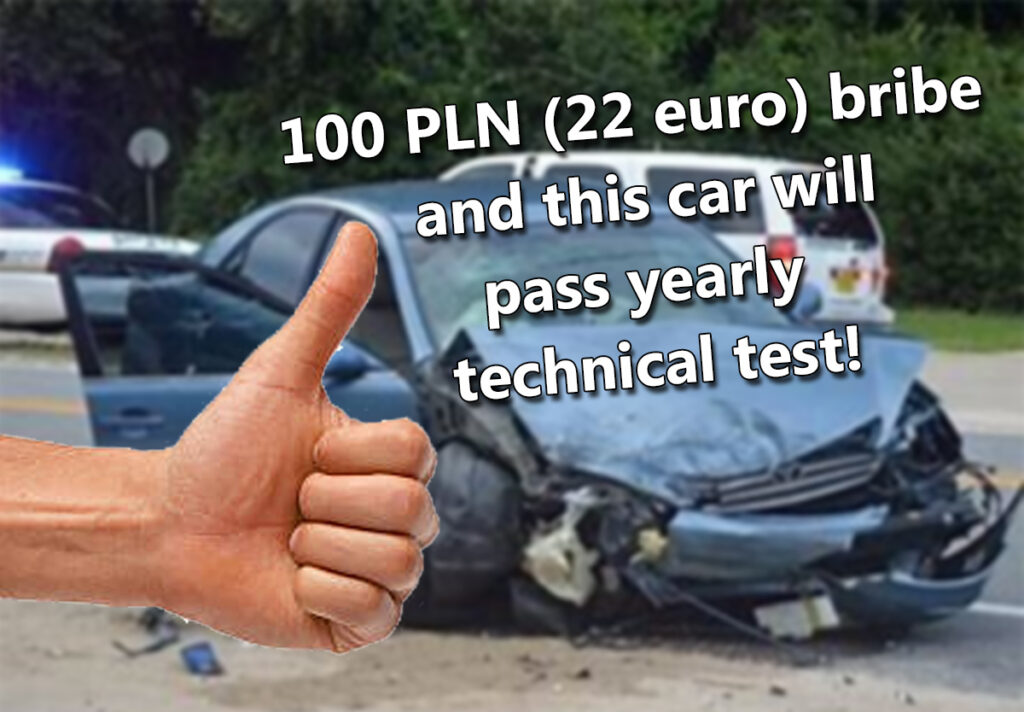
Unfortunately a small bribe (roughly 20 euro) is enough to pass the yearly technical check in Poland. I would not be able to pull such thing off in Ireland where I lived.
In Poland – just give me 20 euro and I’ll be back in 15 minutes… (not advertising any services here, just to be clear)
As a result, not only technically unfit cars can be driven.
Also heavily modified race cars drive on Polish roads with perfectly valid technical test. They would never be allowed on public roads in a country with functioning car testing system in place.
For example switched off ABS is very popular among racers – and equally unpopular among families of killed pedestrians.
Common knowledge among Polish drivers is that the ABS makes braking distance longer, so it is always better to have it off and „maintain full control”.
The idiocy of my fellow countrymen will never cease to astonish me…
Diesel cars with DPF cut out (most of older diesels in Poland) pass technical test in flying colors, every year. How do they pass emissions test is a mystery to me.
The downside is that you cannot leave Poland in such car, as the Germans for example will not show any understanding.
If the car is in a very bad shape, the bribe will be higher as the workshop takes higher risk if you get caught.
Another problem worth mentioning here is the fact that many Polish buy old luxury cars to show off. Then they find themselves unable to afford proper maintenance, parts etc.
So the car may look good cosmetically but technically it is often a disaster waiting to happen. A bribe to pass the test is much cheaper than parts…
People also resort to buying used tyres imported from Western Europe. I guess those tyres are sold there as rubber waste and are not meant to be re-used.
Well they get a second life in Poland. New tyres for powerful luxury cars tend to be expensive.
And one more thing: used cars are significantly more expensive in Germany, than they are in Poland. Yet for some magical reason, a used car imported from Germany becomes less expensive once it crosses Polish border. Same make, model, mileage, even colour.
This phenomenon can be easily explained: the imported cars offered for sale in Poland have serious technical faults that makes them unfit for the road and impossible to legally sell in Germany.
Even the most crooked German car handlers would not dare to sell them to the German public, as first technical checkup would reveal the truth and they would be in for a costly ride or even land behind the bars.
And so these killing machines are sold to Polish and other Eastern European morons dreaming of impressing their neighbours with a luxury car for a fraction of its market value.
I call them morons, because they could have a perfectly working car that would be half the age of their banged up BMW – for the same money.
And they could actually afford to keep the car in proper mechanical order… nope, not here.
Technical testing is yet another area where our state fails miserably – and it is one of the reasons Polish roads are so deadly.
Our government cannot enforce strict technical testing, because it would take a large percentage of cars off the roads right away.
Voters would get pissed off. Thus, yearly technical car test in Poland is pure fiction.
Yanosik – the speeding app
In Poland we have a special mobile app called Yanosik (name roughly translates to „Robin Hood”). The app is a kind of social medium that allows drivers to warn each other against Police check points.
It is a must-have for all those who want to engage in dangerous or illegal behaviour on the roads.
In the meantime, Polish traffic Police maintains close relationship with Yanosik App owners.
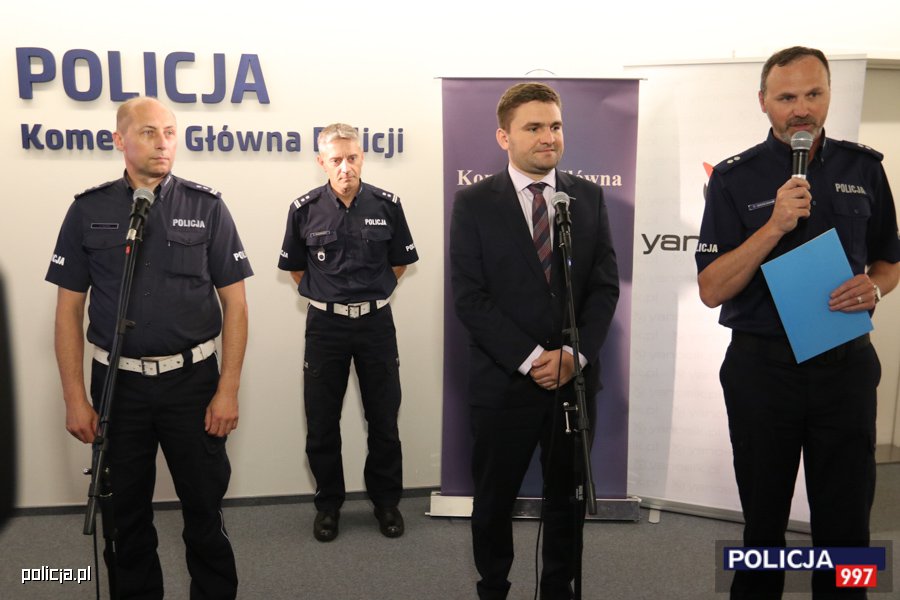
The app is a great help not only for those speeding, but also for drunk drivers, criminals smuggling illegal stuff, guys with active arrest warrant etc.
The app is an invaluable tool for a wide spectrum of criminals, because it simply reduces chances of being caught almost to zero.
As a result of the app, traffic police’s ability to catch those speeding is seriously impaired – not to mention more serious offenders. Amateurs get caught while the most dangerous pros slip through the net.
All the dangerous drivers I know use Yanosik app religiously. They would have lost their driver’s licenses long ago if they did not.
The app and its use is perfectly legal in Poland.
So, if you have been drinking and want to drive, you have a perfect solution if you want to avoid being caught…
This brings us to the next subject:
Drunk driving
In recent times, drunk drivers cause only 9% of accidents on Polish roads. These numbers have seen a good decline in the last couple of years.
This may look quite good, but makes you think when you find out, that only in the first 9 months of 2021 Polish police has caught 70 thousand drunk drivers on our roads.
I guess these were too drunk to turn on the Yanosik app.
It is like 8 thousand monthly, almost 100k yearly.
The population of Poland is around 38 million. About half of it has a driving licence, so we have say 20 million of drivers.
I give you these figures so you can put these 70 thousand drunk drivers (say 100k a year) in the right perspective.
Now take into account the virtual non-existence of traffic police in Poland and existence of forementioned warning app (Yanosik). The reality is that only a small fraction of drunk drivers ever get caught.
If so, why only 9% of accidents is caused by drunk drivers?
Simple: because we have a lot of much more serious reasons to crash, than being drunk behind the wheel. See above and below.
Let us flip this statistic around: sober Polish drivers cause almost 10 times (a thousand percent) more accidents, than drunk ones… Enough to get our roads to the top three of most dangerous European roads.
How do you like that now?
Riding a motorcycle/scooter in Poland
My experience here is limited to a 125cc scooter driven mostly in a city, so I will talk exclusively about city here. I am an unexperienced two-wheeler rider, so my observations should be taken with caution.
In my opinion Polish drivers are not used to two-wheelers on the road. The number of near misses you encounter when swapping a car for a scooter (and I guess a motorcycle too) rises tenfold.
If you have experience driving a car, this sharp increase in near misses and dangerous situations is the first thing you notice when new to two wheels.
You notice it right away that people misjudge your speed and distance, cut in, try share the lane with you, do not treat you as a normal vehicle.
I am talking about normal, predictable and safe riding, large scooter (not a pizza delivery moped), acceleration that beats most cars, almost no overtaking, going with the flow of traffic, no crazy stuff, just going from A to B as if you were driving a car.
I also wear a hi-viz vest – not very common among Polish motorcyclists. A habit from Ireland where I cycled a lot.
I am sorry to say this, but you will probably have to break speed limits in the cities, as otherwise you will not be able to keep up with the flow of traffic.
Being constantly overtaken can be dangerous (people misjudge the size of a motorcycle/scooter too, cut in very close etc.), you will be in the same situation as cyclists.
Sharing the road with cars as a cyclist is a nightmare here in large part because of constant dangerous overtaking. The drivers will overtake even if there is no room. If something goes wrong they will simply push you aside, tough luck.
Choosing to risk the life or health of another human comes natural to Polish drivers. We do not look after one another – not only on the roads. This is – unfortunately – a good indicator of what kind of society we are.
So I guess you will be forced to be speeding in order to avoid this.
I could not care less if people overtake me or get angry when I drive a car to the speed limit, not much they can do to me and with a dual dashcam I am protected from legal problems too.
On a scooter though, I must do what the Romans do. I leave plenty of space cushion in front of me and much to my surprise it is not that common for people to cut in there.
I guess it is because I ride at the same speed as them. They see no benefit.
They do it when they want to change lanes which is perfectly fine. I just roll off the throttle and have my space cushion back. I do not find maintaining space cushion difficult.
You will notice that some car drivers will overtake you even if you are not an obstacle and maintain your position in the flow of traffic. I think they perceive a scooter as a slow vehicle even if in fact it is as fast as a car.
So they will overtake based on what a scooter is, even if it makes no sense and does not improve their situation on the road.
They also are afraid to get stuck behind you, not knowing that you can do normal speeds like a car. I think that knowledge about two-wheeled vehicles, their types and capabilities is very limited among Polish car drivers.
So expect hastily overtaking especially by large powerful cars – even if you show no signs of being a potential obstacle and there is no need for such manouvre.
These guys got stuck behind Uber Eats moped too many times and think you will be the same. I guess motorcyclists get a bit more respect here and are not being overtaken as often as scooters, if at all.
I do not lane filter when the cars are in motion (I do not have enough skill to manage this safely) but a lot of motorcyclists do. Thus there is never a chance for them to be overtaken.
In many Polish cities you can rent small electric scooters/mopeds with companies like Blinkee. I mention them, because I do not think they are such a good idea.
While on a 125cc scooter or a motorcycle you can easily keep up with the city traffic, on a small electric scooter you can’t. 50kph speed limit in cities is fiction. Bear in mind your electric scooter’s speed is capped at 45 kph.
You become an obstacle and Polish drivers do not like obstacles. You are something the drivers here are not used to – this adds to the risk.
Moreover – while you will get a helmet (not a full-faced one though) along with the scooter, you will not get any other protective gear like a jacket or gloves.
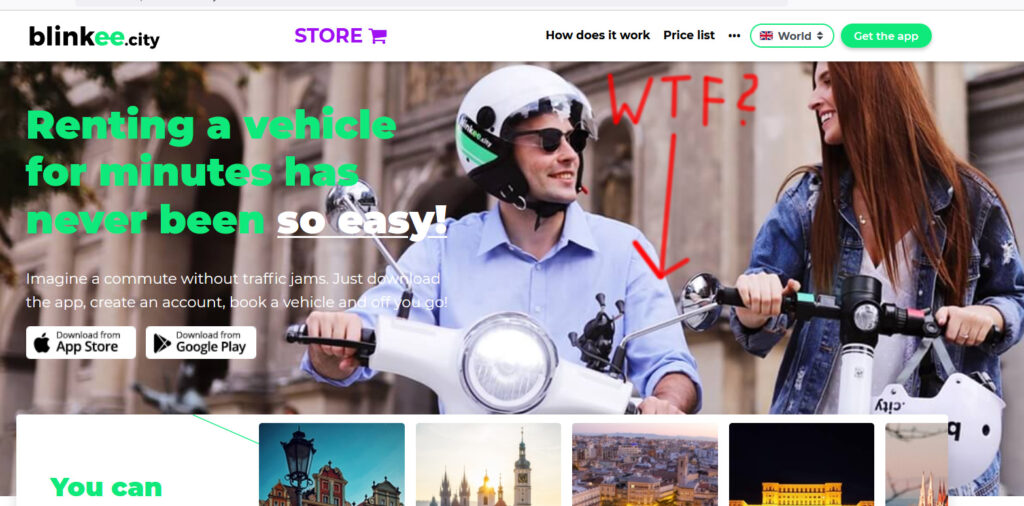
So you become a slow unprotected motorcyclist in a city traffic surrounded by drivers that are not very familiar with the type of vehicle you are riding.
You fall into the „nuisance” category like some old guy riding his mobility scooter on the road or a cyclist who refuses to use bicycle path and rides on the road instead. One more thing that prevents me from getting home fast.
It may be lots of fun to discover the city on a scooter, do not get me wrong. I am just not sure if a small electric one doing 45kph tops is your best choice.
I would try to rent a 125cc (in Poland category B licence held for 3+ years is enough, EU licences are accepted even if you can’t drive 125’s in your own country), you can usually rent proper riding gear there as well.
Useful information: lane splitting is legal in Poland and I did not notice it causing car driver aggression.
Super-lenient penalty point system
Penalty point system in Poland was created with strict adherence to „do not piss the voters off” principle. It is designed to minimise the possibility of any serious consequences as much as possible.
It works in tandem with super-low penalties for road traffic offences to make sure Polish roads continue to be the most deadly in the EU.
Like not too many things in Poland, this system really delivers producing high number of injuries and road fatalities every year, without failure.
In order to be disqualified from driving, you have to collect 24 penalty points in any given year. After a year your points go back to zero.
The police can give you a maximum of 10 penalty points on a given occasion, even if the offences you committed are worth a 100 points.
This means, that in order to be disqualified from driving, you have to be caught a minimum of three times in a given year. This is provided you will be given 10 points on each of the two first occasions you are caught and then 4 or more points on the third occasion.
This is extremely unlikely to happen, even without the Yanosik app mentioned before.
As a result, Polish penalty point system is completely pointless – pun intended.
Insurance
In Poland insurance is tied to the car, not to driver. So say I have just passed my test and want to drive my grandma’s Ferrari. No problem here, work away grandson.
I could be disqualified from driving ten times, and I still can drive my grandma’s or anybody else’s car and be covered by their insurance.
Thus, compared to say UK or Ireland Poland is boyracers’ paradise.
I really hated the Irish insurance cartel and paying through the nose for nothing (I never had any claims). But they were some barrier to those with repeated offences and certainly a significant financial deterrent for boyracers.
In Poland insurance companies have no access to your driving offences’ or penalty points history, as the Polish courts say giving them access would mean punishing you twice for the same crime.
It is a fair point, but why should I be punished then by paying someone else’s insurance premiums?
In Poland all safe drivers get punished collectively for road offences and careless driving of boyracers and reckless idiots who enjoy low insurance rates at their expense.
In recent years (2019-2021 area) insurance rates in Poland have seen a sharp rise. Driving a mickey-mouse 1.4 automatic car, with zero claims ever on my record I pay almost same amount as I used to in Ireland…
As usual in Poland, criminals enjoy better state protection than law-obeying citizen.
Second chances are given indefinitely. So you can do whatever you want while we pray that you do not kill our children.
Important People (no media coverage, no justice)
Thankfully the group is relatively small in numbers, but still extremely dangerous if you have the misfortune of meeting them on the road.
It consists of politicians (but not the leaders, more like the second or third row), business people, lawyers, celebrities and their families.
Just like the famous agent 007, those people effectively have a licence to kill on our roads. Their only problem is that this licence is most effective as long as the case is under the media radar.

Most commonly those people are given indefinite „second chances” when it comes to drunk driving and driving while disqualified.
For example „artistic achievements” can be used as justification for a lenient sentence. Used in the court of justice (drunk-driving case of a singer), these are judge’s words, thus in inverted commas as this is a quote.
I wont bore you to death telling their stories but there are cases like a woman killed an 80 years old man on a pedestrian crossing and the court said that was the mans fault as he „invaded” the crossing.
Problem is the guy was using a walking stick and could not walk fast, leave alone running or „invading” the crossing.
After the accident the lady who drove ran out of her car with her phone in her hand…
A car stopped in another lane to let the poor old guy pass (so it was possible to see the man and stop), she drove over the speed limit (she drove a Mercedes, it has a system that would spot the pedestrian and brake autonomously, but she drove too fast for the system to engage as it engages up to 70km/h).
The list of curious things goes on. The deeper you go the more disgusting the case gets.
Looks like the whole justice system worked to help the perpetrator to get away without a sentence.
Nobody cares about the old fart who got killed, he lived long enough. There should be some understanding for „quality people”.
Only because the case caught public attention, Polish Minister of Justice ordered a review. God only knows how much of it is PR and how much a real will to get to the truth and serve the justice.
If you are interested, some details (autotranslated website) here. BRD24 is Poland’s largest road safety related website.
Important People can usually get out scratch free as it takes the minister and lots of media attention to get their case reviewed properly.
The minister is a busy man, he cannot supervise every single case where politician’s son killed a child while being drunk behind the wheel.
The sad reality is that when Important People are involved, media coverage is what decides if you get justice or not.
No media coverage, no justice.
Being a pedestrian (aka „dead man walking”)
If you are a pedestrian in Poland, you have to understand that in this country pedestrian crossings are the place where most pedestrian deaths occur.
No I am not joking or making this up – it is a solid fact.
If you kill someone on a pedestrian crossing in Poland you will most likely walk away with a suspended sentence, even if you drove well above speed limit.
Only if you are drunk there may be some more severe consequences, but most of the time there is nothing to worry about.
Pro tip: if you run over a pedestrian while drunk, leave the scene immediately. Go to the police once you sober up. If they come to you earlier (very unlikely) tell them you drank after the accident, out of stress. Works most of the time.
Usually the court will assume that the pedestrian entered pedestrian crossing in a sudden or unexpected way (an expression “the pedestrian has invaded the crossing” is often used).
You see, nobody expects pedestrians on pedestrian crossings in this country… they always come as a surprise.

As a pedestrian in Poland you should exercise extreme caution. Polish drivers are reluctant to stop to let pedestrians cross the road (there are rules that clearly regulate this, but again Polish drivers consider those rules to be more like guidelines).
Make sure the car stopped completely before entering pedestrian crossing.
Also, make sure no other vehicles are approaching at high speed, as they may hit the vehicle that has stopped to let you cross. The stationary vehicle will then move forward and hit you. Such situation looks like this:
Also, if there is more than one lane, make sure that vehicle in the second lane has stopped too – many drivers do not stop and pedestrian who thought to be safe on the crossing gets killed.
New regulation is to be introduced in June 2021, that even more forbids killing people on pedestrian crossing.
Do not get fooled by this PR gimmick, no enforcement of any kind will follow.
The poor child running on all four for her dear life is Polish roads in a nutshell.
Do you want your own child to run like this? Get traumatised on holidays by some braindead thug who in a civilised country would not be allowed to drive a shopping trolley?
In Poland this imbecile is still out and can drive a machine capable of doing 300km/h.
Foreigners are more vulnerable on Polish pedestrian crossings, because they are not aware of the danger. They assume the drivers will behave like in their own country.
Wrong, deadly wrong.
As cyclists are afraid to ride on the roads (for a good reason), they ride on pavements. So if you are walking on a pavement in Poland, behave as if you were a vehicle, look back when „changing lanes”.
There may be a bicycle behind you, that does not expect you to change direction and hit you from behind.
As you can see Polish drivers’ aggression causes problems that are not contained to the roads, hospitals and graveyards…
Watch out for cars on pavements (and bicycle paths)
It is important to know, that in Poland car traffic is not limited to roads.
Expect to meet cars on the pavements and bicycle paths regularly.
Pavements and bicycle paths are commonly used by Polish drivers if there is a traffic jam, if they want to park on the pavement nearby, if they have a delivery to make and indeed in all other cases when it suits them.
Yes – the guidelines (aka rules of the road) do say it is illegal but it is still better to watch out rather than being struck by a delivery van reversing on a pavement.
In Poland cars driving and parking on pavements and bicycle paths are a common sight.
Normally – as they cannot see what is behind them – the drivers reverse slowly to give pedestrians plenty of time to jump aside. Consider the video below:
Moreover, drivers expect pedestrians to move out of the way so they can pass. Please do get out of their way, especially if they are reversing and cannot see you.
Interesting experiments have been conducted by various activists involving not moving away to let the car pass on the pavement.
It happened on a couple of occasions, that driver not being able to leave the pavement called the cops.
And what do the traffic cops do in such case? They order the pedestrian to get off the pavement and let the car pass.
This is correct: in Poland the police can order a pedestrian not to stand in a certain place on a pavement in order to allow illegally parked car to move.
Even simpler: the police controls where on the pavement you are allowed to stand and how long for.
No wonder that in Poland pedestrians die not only on pedestrian crossings, but on the pavements too. Especially small children who due to their height are not visible from the cars.
Dual use of pedestrian crossings
It is worth explaining, that in Poland pedestrian crossings are commonly used as access roads to pavements and other areas Polish drivers choose to share with pedestrians or cyclists.
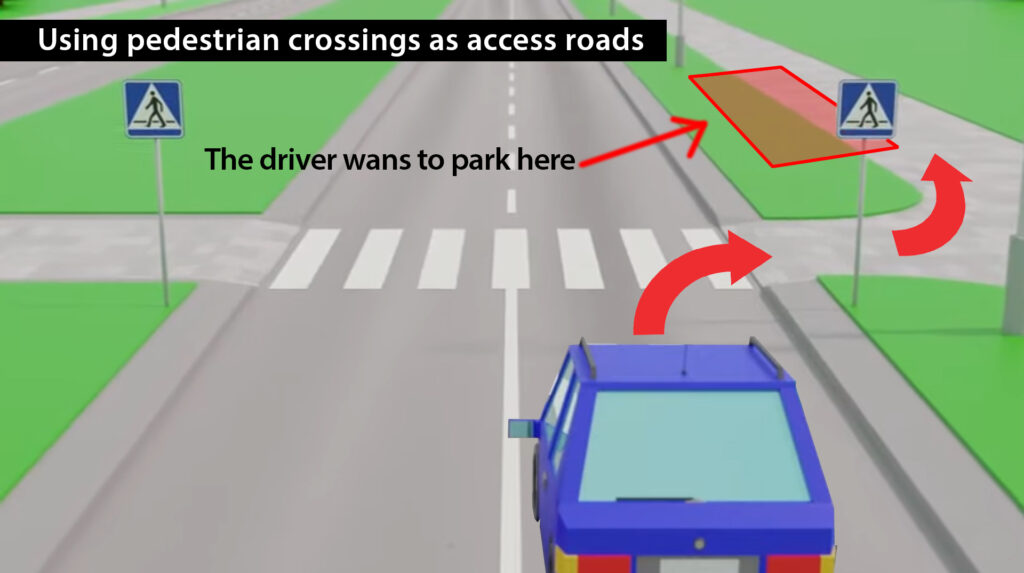
Expect cars to turn and enter the pavement through the pedestrian crossing. They may want to park somewhere there, do a delivery, or want to drive on the pavement for some other reason.
Remember to get out of their way promptly.
Cycling in Poland
Do you want to live? If so, then forget about it. Drivers in Poland hate cyclist just as much as they hate those who obey speed limits.
In Poland cyclists are treated as a nuisance and an obstacle. Aggression towards cyclists is commonplace.
As mentioned, in the cities cyclists are afraid to ride on the roads and ride on pavements instead – causing more problems and accidents involving pedestrians…
If you want to cycle, go somewhere else. There is plenty of countries with cycling infrastructure and sane drivers.
If you want a simple advice, here it is: because of the grave safety concerns I have, I would never allow my own child to cycle on Polish roads.
Myself I would ride only on bicycle paths and pavements, no roads. Also, I wear a cycling helmet, hi-vis vest and gloves all the time when cycling.
There are penalties for riding on pavements in Poland, but like all penalties here they are small and unlikely to be handed to you. It is small risk compared to riding on the roads.
In Poland you will face a very typical Polish choice: penalty for riding on pavements or being hit by some thug (sorry, I meant voter of course) on the road. Pick your poison.
Remember, on our roads it is the thugs who run the show. Be in the wrong spot at the wrong time and they will run over you too – and most likely walk away without any legal inconveniences.
Meanwhile, if lucky enough to survive, you will be in Polish hospital – and Polish hospitals can be just as dangerous as our roads.
I hope you get the point.
Disabled drivers in Poland
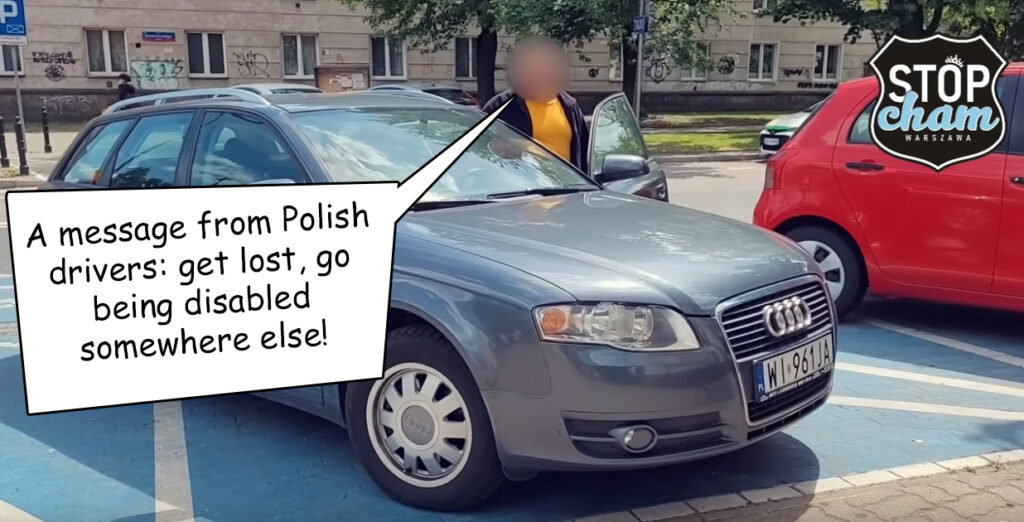
In short: go being disabled somewhere else, will you?
Still here you stubborn cripple? Ok, let us go on then:
In Poland the only difference between you and healthy road users will be the fact, that you can become more disabled on Polish roads, while they can become just disabled.
Bad joke? Sorry.
Your biggest worry as a disabled driver will be finding a parking spot. Let me explain.
We do have designated and clearly marked disabled parking spaces in Poland. Their number is sufficient.
Well it is sufficient for the disabled, but unfortunately they are not the only users of disabled parking spots.
I would say that in Poland the real disabled drivers may even be a minority among users of those spaces.
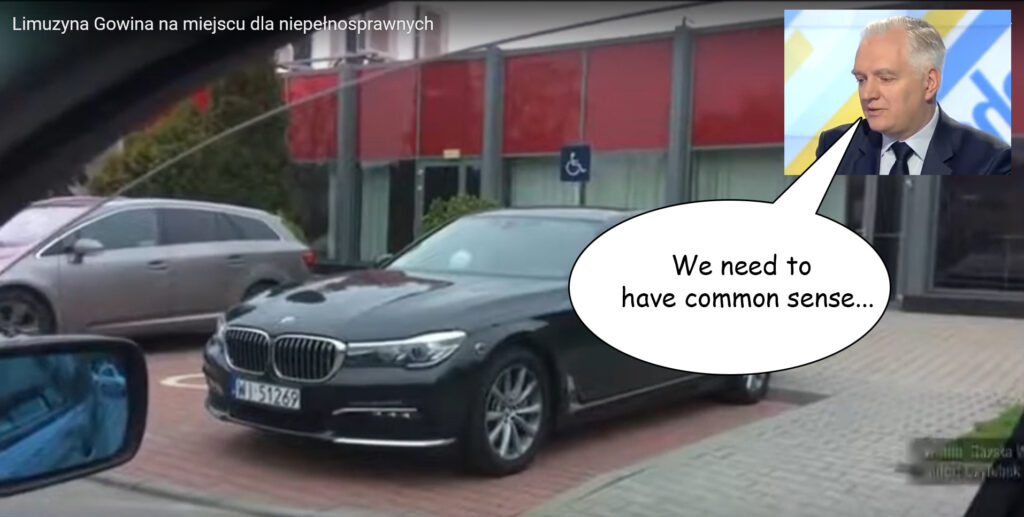
I know this may sound unbelievable, but it appears that in Poland a lot of perfectly healthy, strong and fit people own disabled parking cards.
I see cars that are not modified for disabled drivers, without any hand controls and other mods easy to spot for those who know how they look like.
How can you explain a perfectly healthy person using a car with disabled parking card?
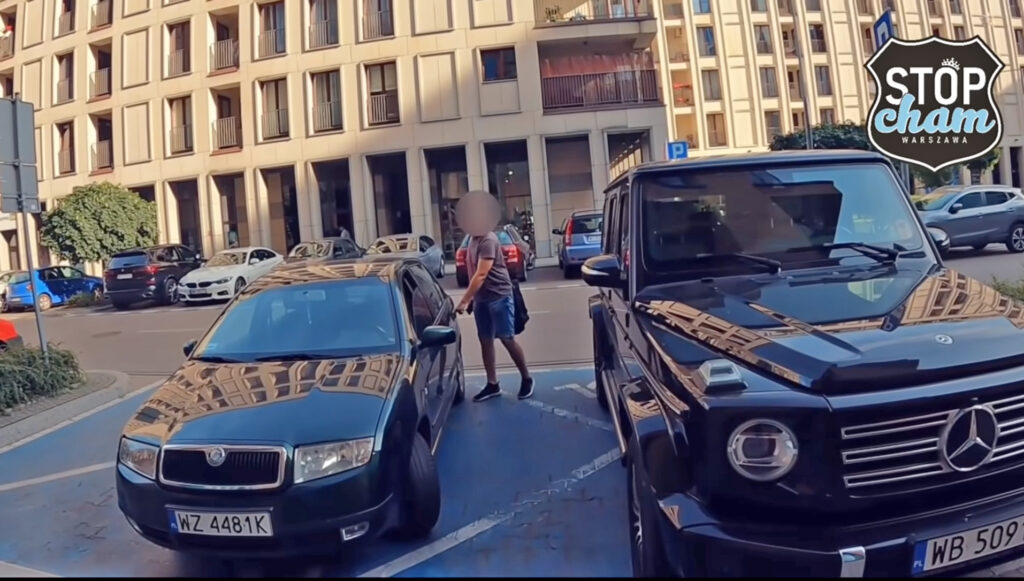
So, many of the disabled parking spaces will be occupied by cars whose owners do not seem to suffer from mobility problems, nor do their passengers.
Strange.
Apart from „suspicious” group, there will be plenty of other cars parked on disabled spaces completely illegally.
Those cars are owned by those who simply can afford paying fines and do not care.
Combine this with virtually no enforcement and… you’ll have to find another parking spot you entitled cripple.
You have to understand that quality people have a business to do here, they can’t be late to the gym as their personal trainer’s time costs money.
There is also a third, lowest tier of people who use disabled parking spots. As they cannot afford penalties, they park directly in front of disabled parking place and block it.
Technically they do not occupy the blue spot, so they are not liable for the higher fine. In an unlikely event of being caught they pay just for illegal parking, but not for parking on disabled space.
Smart move, is it not?
But as they block the access, you won’t be able to use the space anyway so it is of little help to you. Helps them to reduce their exposure though.
You may have some weird ideas to ask those parking illegally to leave so you can park.
Please don’t do this. People who park on disabled spaces get very angry when you call them on it. They really dislike people who tell them what to do, as they are used to doing whatever they like.

Don’t fight the system, the battle is already lost. In Poland we are officially unable to enforce this bit of civilised behaviour.
So, to wrap things up – I discourage you from being disabled driver in Poland.
Get well soon or go being disabled somewhere else.
How to survive on Polish roads?
The best strategy is to avoid Polish roads. Better safe than sorry.
A couple of bullet points below summarise the most important things in case you are forced to partake in road traffic in Poland.
Please do take them seriously. They will improve your chances of survival.
- on motorways stick to the slow right lane (remember, left lane in Poland is reserved for drivers who drive way faster than speed limit)
- outside cities constantly look out for risky overtaking, brake and escape to the hard shoulder/roadside ditch as necessary
- do not react to any offensive gestures and other provocations
- lock your car’s doors when driving
- if forced to stop/attacked do not leave the vehicle no matter what – most attackers will not resort to breaking windows
- do not enter pedestrian crossings if not absolutely sure that all vehicles have stopped
- have a dual dashcam (front and back)
- have a can of pepper spray with you always when driving
- As BMWs and Audis are the preferred „weapon of choice” of Polish road thugs, be extra careful when encountering these car makes. Also avoid renting such makes (your genuine mistakes may be taken as intentional aggression).
- do not cycle unless you have a death wish
- don’t be disabled
If you would like to view more videos showing aggression on Polish roads just see here (youtube)… you will quickly realise that what I have shown here is just a tip of an iceberg and certainly not cherry-picked exceptions.
Be prepared, know what to expect, consider the risk carefully.
Is There Hope?
In recent years a new Polish Traffic Police task force called „Speed” was created. Its aim is to „eliminate the most dangerous drivers from the roads”.
They operate in unmarked cars and are currently the only realistic threat to the particularly dangerous road offenders.
I think Speed group is exactly what we need in Poland at the moment, because we won’t have normality anytime soon anyway.
So we should be happy with anything good that happens.
I saw dashcam videos where drivers recorded „Speed” group’s interventions and literally cheered – they were so happy seeing this bit of sanity and order restored .
This is how badly we need them on our roads. So keep up your good work guys, because…
…our only other hope is the EU taking over and forcing our bunch of clowns to finally restore the rule of law on our roads.
We are permanently unable to fix the issue ourselves, due to the voter-politician stalemate I explained earlier.
I am sure that our politicians would be more than happy to finally fix the pathological situation on our roads – if they could blame this on EU and thus keep their face.
So unless the EU comes to save us, this is where we are headed, with gas pedal to the floor:

